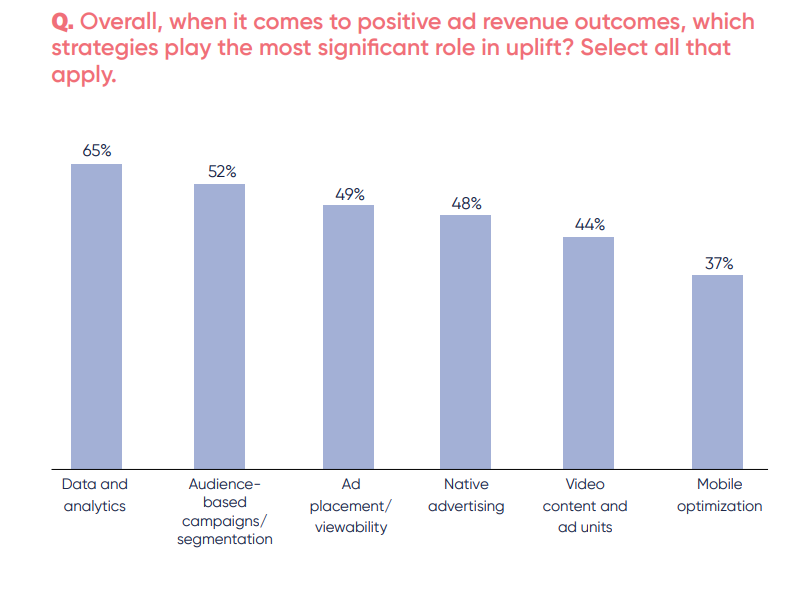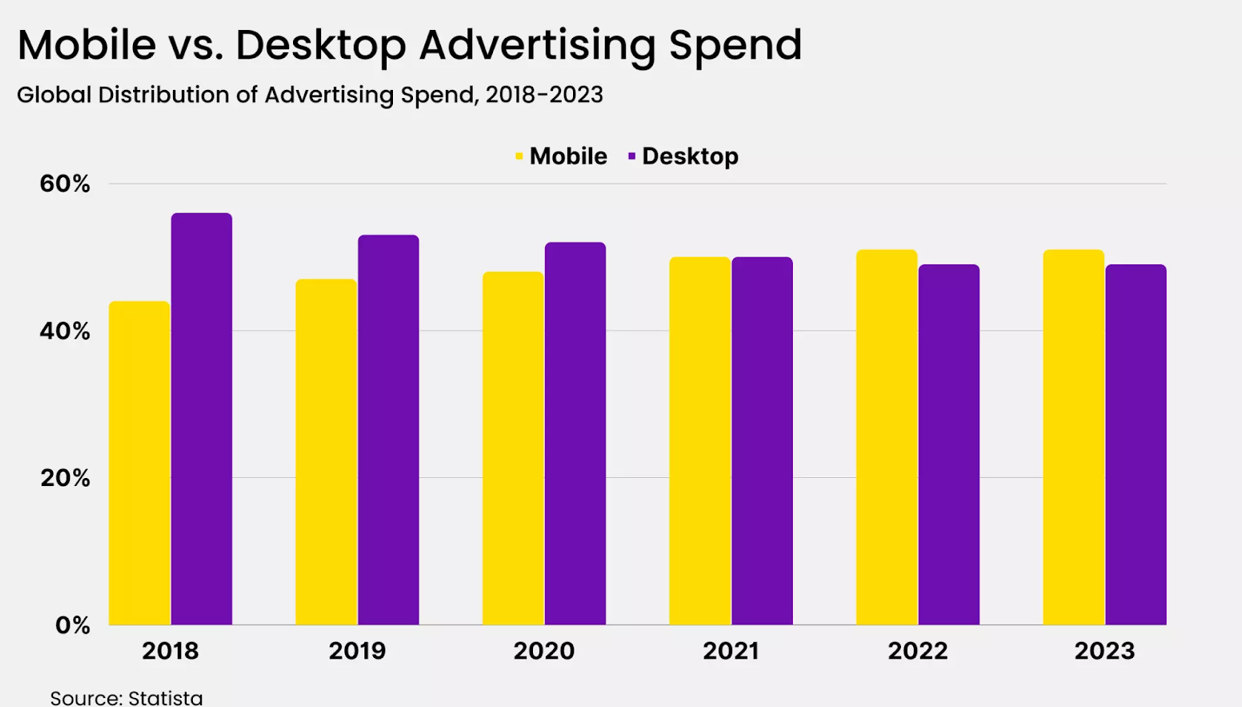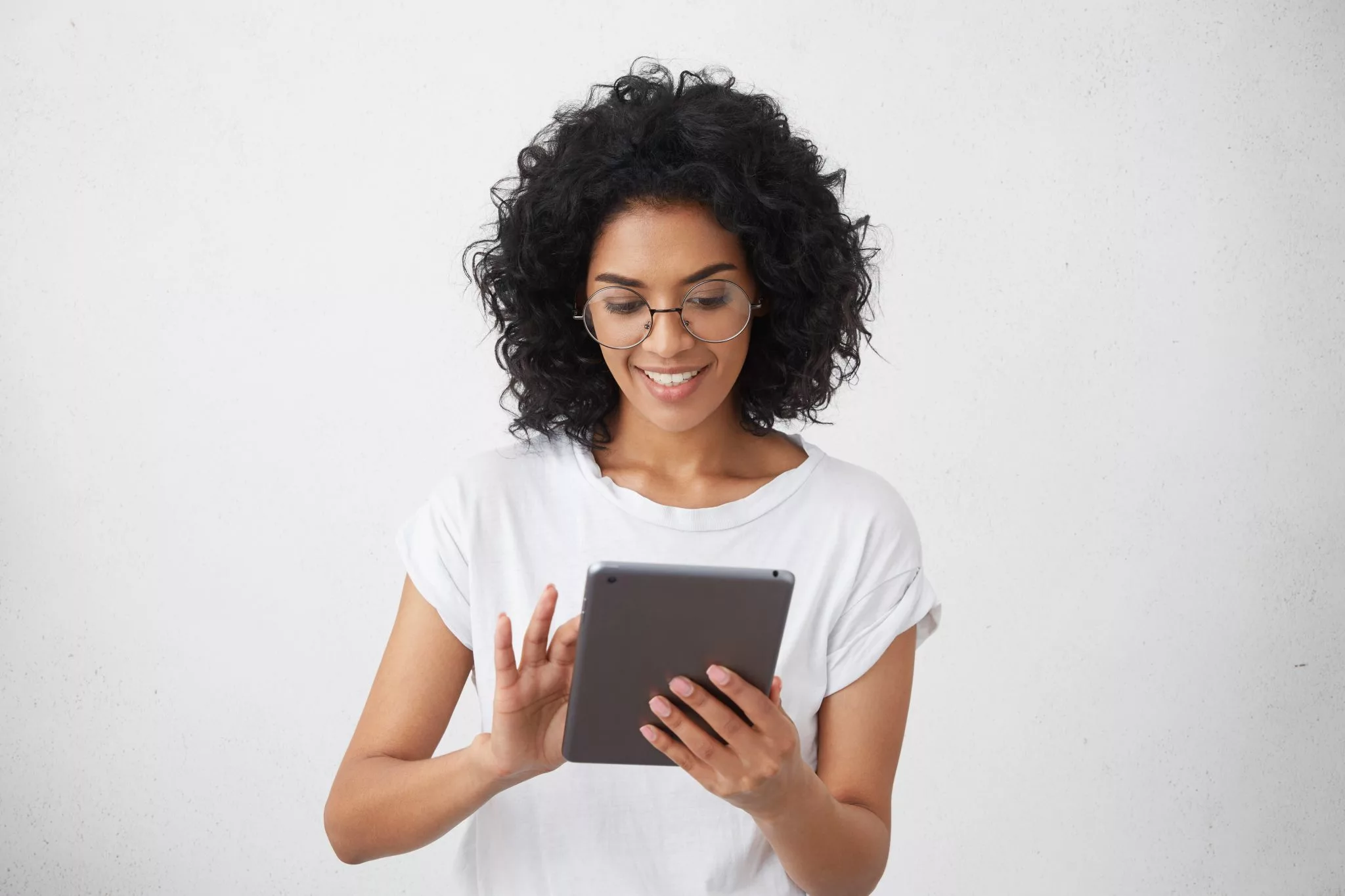According to the recent Digiday survey, publishers were asked to tick the strategies that give them an uplift in ad revenue. Ad placement secured third place in the list, with 49% favoring it.

This statistic reveals that ad placement is one of many factors influencing ad revenue.
As a publisher, you can’t just place ads on a website, which won’t generate maximum ad revenue. This is where the ad placement comes in, and its optimization is ideal to ensure that the ads are in the best locations and formats.
But how do you know where to place ads? Do you put them wherever there’s a room? Should they be placed above or below the fold? How much space should you allow for ads on the page?
In this blog, we’ll answer all these, along with the best practices for optimizing ad placements for publishers. By following these tips, publishers can increase ad revenue and improve the user experience.
Table of Contents
What Is Ad Placement? Why Is It Important?
Ad placement refers to placing ad units in an optimal location on a website or app where publishers can reap maximum revenue. Finding a good location depends on many factors, such as user behavior, ad size, ad types, ad format, relevancy, etc.
Optimizing ad placement is important because not doing so will only decrease ad revenue. While there are many advantages in optimizing an ad placement, a few key benefits are covered here:
Improves user experience: The ideal ad placement, decided based on relevancy and user behavior, gels seamlessly with the website. This will increase user experience and engagement with ads.
Improves ad viewability: Placing an ad at an optimal location that blends well with the user’s flow can increase ad viewability. Ad viewability matters to get high impressions, clicks, and conversions on ads to improve ad visibility and attention.
Increased CPM and ad revenue: It is obvious that inventory with optimal ad placement performs well. Therefore, you will get high CPM for your ad units, eventually increasing ad revenue.
Types of Ad Placement
Yes, before stepping into optimization, it is important to know the ideal locations for ad placement on websites.
The location of ad placement depends on different ad types, such as banner ads, native ads, and video ads. Here, we have covered the most-used ad placements for better ad revenue.
Above the fold and below the fold: It is very common that for ad placement, we first decide whether to place it above the fold or below the fold. Above the fold are usually preferred for premium ads as they have a higher viewability rate and CTR than below-the-fold ads. Below the fold can be used to place ads in strategical locations to increase ad impressions and conversions.

Sidebar: This location refers to the left or right side of the website where we can place ads of sizes from medium rectangles to skyscrapers. And it can be static or dynamic. The sidebar ads on the left are used most, and the ads placed there will be visible to users regardless of scrolling.
In-content: These ads appear in between the content where the natural transition occurs from one paragraph to another.
Interstitial ads: These ads appear on the user screen when there is a natural transition between one page and another. They cover the screen fully and are less intrusive than pop-up ads.
Factors to Consider Before Ad Placement Optimization
When you decide to optimize ad placement to increase revenue, you need to take care of certain prerequisites. Those prerequisites can help you decide right ad placement to increase user attention and revenue.
Analyze your traffic: The first step is to analyze the traffic, individual page views and find the pages getting the most traffic. Segmented data on your overall traffic by geolocation and other demographics helps you decide the ideal ad placement combined with ad types and sizes. You will also know which ad locations or sizes are not suitable for users from different geographic areas.
Performance of old ad placement: It is better to check the performance of old ad locations to find which are working and which are not. This will help you change only the locations that are not performing well. Also, you can keep this as a baseline for further optimization and improvements.
Ad viewability: This is an important metric to track to check whether your ads are seen or not. According to Digiday, 54% of ad creatives are not seen. So, consider measuring the ad viewability of your ads with respective to location. This will help you find or reject locations that increase or reduce ad revenue.
Best Practices for Optimizing Ad Placements
Optimizing ad placements for publishers is an important part of maximizing revenue. Several best practices can be used to ensure that ads are placed most effectively.
-
Consider User Experience:
User experience is crucial when optimizing ad placements on a website.
According to a study, delays in website loading can significantly affect user satisfaction and their likelihood of returning to the site. Even a 2-second delay on unfamiliar sites can cause a significant drop in user satisfaction.
Your users are more likely to engage with ads that are not intrusive and do not disrupt their experience on the website. Ads should
- Be placed where they can’t easily be mistaken for a part of the website’s design or content.
- Never interfere with users’ interaction with the page they view.
- Not slow users’ browsing experience or take up too much memory on their device (desktop, phone, or tablet).
Moreover, ad placements should be relevant to the content. As per a report published by GlobalWebIndex, approximately 29.2% of individuals prefer ads relating to their identity or interests.
Another survey (of about 1,000 members) from DISQO stated that the majority of respondents, comprising 81%, feel positive, with 51% feeling positive and 30% feeling extremely positive when encountering a relevant ad.
While ads can be made relevant based on the user’s behavioral and contextual data, a privacy-compliant way would be to go with the latter. For example, you may place the ads on multiple locations across the website based on the audience’s interests, such as placing ads for travel deals near articles about travel or sports-related ads in articles related to sports.
-
Use multi-sized ad placements:
By using multi-sized ad placements on a website, publishers can improve their ad revenue by providing advertisers with a wider range of ad sizes, thereby increasing the likelihood of ad placements and clicks.
Choosing ad sizes with a high ad viewability rate is wise. Vertical ad units are the best option for increasing ad viewability. According to Google, the popular ad sizes with higher viewability rates are 468×60, 300×600, 970×90, 728×90, and 300×250.

They also enable publishers to optimize their ad layout and placement, ensuring that ads fit seamlessly into the website’s design while still standing out to the audience.
-
Use Lazy Loading:
Lazy loading is a technique that optimizes website performance by loading content only when needed. This approach is particularly useful for websites with many images, videos, and ads, as it can significantly reduce page load times and improve the user experience.
By implementing lazy loading on a website, publishers can optimize the placement of ads by only loading them when they are visible to the user. This approach can help reduce the number of ad impressions wasted on users who never see the ad, thereby increasing the value of each impression and improving the overall effectiveness of the ad campaign.
Additionally, lazy loading can help to reduce the load on the website’s servers, resulting in faster page load times and improved user engagement.
Insider tip: Using the intent observer API is the best practice for improving ad revenue with lazy loading. This API detects what is coming in and going out of the user’s viewport and informs the server to load ads accordingly.
-
Place ads in strategic locations:
The placement of ads in strategic locations plays a crucial role in the success of any advertising campaign. Publishers can boost their odds of grabbing the interest of their intended viewers and improving clicks and conversions by strategically positioning their ads.
Some of the most effective ad placements include:
- In between paragraphs: Placing ads between paragraphs of content can effectively capture readers’ attention without interrupting their reading flow.
- Above and below images: By positioning ads above or below, it is possible to capture the user’s attention and enhance the ad’s visibility.
- Sticky units: Sticky Ads remain static on the screen, even as the user scrolls up or down the page. This approach can effectively ensure the ad remains in view and does not disappear as the user navigates through the website.
-
Test different ad placements:
There are many different ad placements, each with its strengths and weaknesses. A/B testing can compare placements and formats to see which ones generate the most revenue.
For example, you can try a native ad on the right rail and then a display ad at the top of the page. You can also test different sizes of banners or text links against each other to see which generates more revenue.
If you test two different ad sizes, you will show one size to half of your visitors and the other to the different audience segments. The best size will then be used for all visitors in future campaigns.
-
Consider mobile optimization:
Mobile devices are becoming more popular and an important part of the online advertising landscape. As 5G becomes more widely available, it is projected that mobile advertising will make up 51% of the total ad spending by Statista.

With the increasing use of mobile devices, publishers should optimize their ad placements for mobile devices. This includes using responsive ad units* and placing ads in locations that are easy to access on mobile devices.
*A responsive ad unit automatically changes its dimensions based on the device it is served on. This means that if a publisher uses responsive ad units in their website, they won’t need to make adjustments for mobile visitors (for example, making an image smaller so it fits better on mobile screens).
Another way to optimize ad placement is to serve mobile-friendly ad sizes. This means they’re not too big and don’t have much text or other elements.
Use tools to find better ad placement
Before deciding on ad placement, it is important to understand the current status of your web pages, such as which page is getting high traffic or which page is ideal for displaying premium ads. These insights can be extracted with the help of measurement and analytic tools.
Google Analytics: This is a highly insightful tool for analyzing page-wise traffic, user segmentation by different geographics, and data from various points of view. You can use the data extracted from Google Analytics to choose high-traffic web pages and find premium locations for placing premium ads to increase viewability and revenue.
Heatmap tools: These tools are appropriate for finding the best locations on web pages where the user’s eyes are glued to or interact with. It is one of the necessary tools to find an ideal ad placement location.
Google Ad Manager: The GAM dashboard can give extensive reporting on ad performance by ad location, size, type, and format.
Third-party provider: If you connect with a third-party provider, they can give you access to an effective dashboard that gives detailed insights on ad performance based on placement as well. The insight gives real-time ad and bid performance data to change auction and ad-serving settings for further improvements that will uplift CPMs and revenue.
Want to connect with a trusted third-party provider who offers the best ad management solution? Contact us now.
Taking Action to Optimize Ad Placement
Taking action is the first step towards optimizing ad placement, and it might not be as difficult as you think. You could increase your content’s engagement, change your website structure, or even employ new advertising techniques.
Ultimately, it depends on your goals and the challenges you’re facing, but the point is that plenty of options are available to you. We can’t tell you which approach will work best for your website. The only way to find out is to take action and measure the results.























